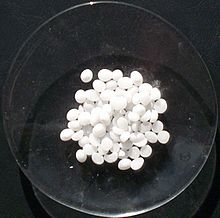Our website is made possible by displaying online advertisements to our visitors.
Please consider supporting us by disabling your ad blocker.
Lye


A lye refers to sodium hydroxide and potassium hydroxide. The word lye most accurately refers to sodium hydroxide (NaOH)[citation needed], but historically has been conflated to include other alkali materials, most notably potassium hydroxide (KOH); though, in many cases, potassium hydroxide is also referred as lye. To distinguish the two, sodium hydroxide may be referred to as soda lye; potassium hydroxide may be referred to as potash lye.
Traditionally, it was obtained by using rainwater to leach wood ashes (which are highly soluble in water and strongly alkaline) of their potassium hydroxide (KOH). A caustic basic solution is produced, called lye water. Then, the lye water would either be used as such, as for curing olives before brining them, or be evaporated of water to produce crystalline lye.[1][2]
Today, lye is commercially manufactured using a membrane cell chloralkali process. It is supplied in various forms such as flakes, pellets, microbeads, coarse powder or a solution. Lye has traditionally been used as a major ingredient in soapmaking.
- ^ "How to make lye". wikiHow. 15 January 2024. Retrieved 24 January 2024.
- ^ Garms, Gabe (9 December 2015). "Turning your wood ash into lye for soap making". Raven’s Roots Naturalist School. Retrieved 24 January 2024.
Previous Page Next Page


